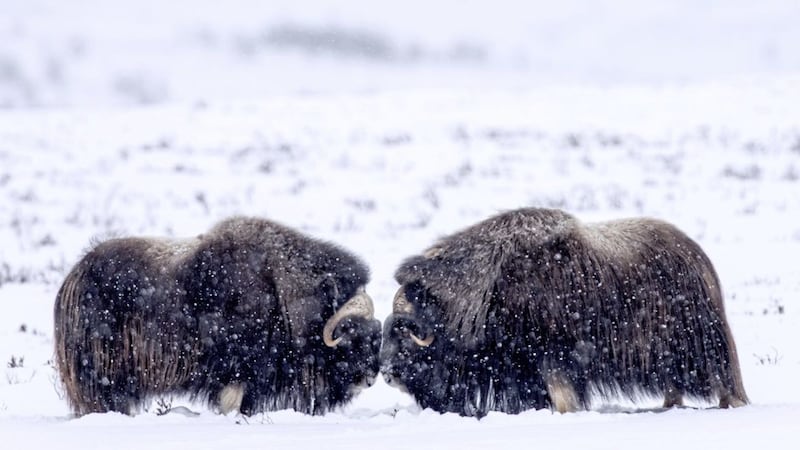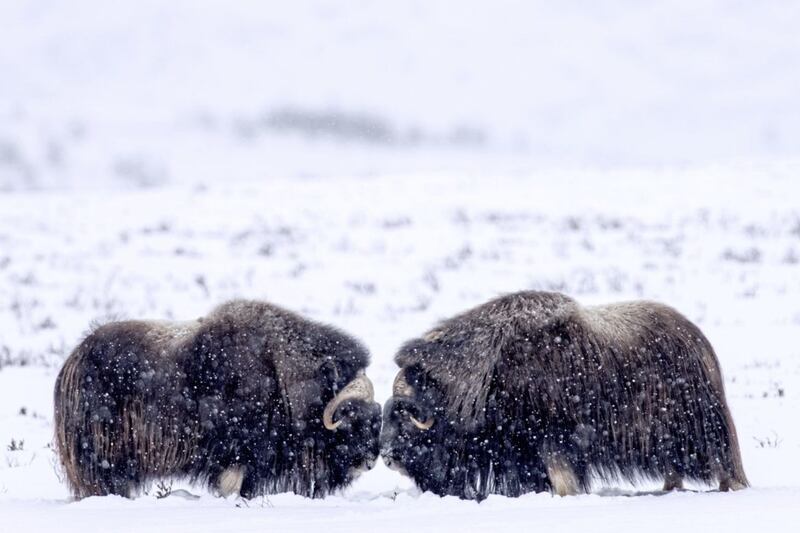IMPLAUSIBLE as it may seem, it is possible to overheat in temperatures of –10C. I discover this while heaving up a steep-sided valley in Norway's Dovrefjell National Park, smashing my racket-shaped snowshoes against the indomitable terrain as if I'm serving an ace.
Peeling away sodden layers of merino wool like shells of an onion, globules of sweat drip from my brow and freeze. I'd glug from my water bottle if it wasn't an ice-lolly; eating snow is the only thirst-quenching option.
We've been trekking for three hours, spiralling through brittle, life-drained forests and over smooth, snow-blanketed granite mounds, in search of the park's enigmatic but dangerously volatile resident: musk ox.
Roughly 260 of these ancient Arctic mammals graze here year-round, sweeping the mountains with a scraggy mass of unkempt hair and mopping up lichen, moss and grass in the process. Contemporaries of the woolly mammoth, their resilience is remarkable; occupying this planet three times as long as Homo sapiens, they've weathered ice ages, human hunting and disease.
But this Norwegian community is much younger. In the 1920s, musk oxen bones were discovered during the railroad construction in nearby town Oppdal, suggesting conditions would be favourable for their reintroduction. Ten animals were shipped from Greenland in the 1930s, although most were shot and eaten during the Second World War. Allegedly, one was even presented to Hitler as a trophy.
A second group successfully settled between 1947 and 1953, and were largely ignored by science.
Then, 20 years ago, Johan Schonheyder of the company Musk Ox Safari began guiding tourists to see the bovidae beasts (which are actually closer relatives to sheep than cows).
Most people come in summer, when clement weather makes hikes much easier and females come down to the river Driva to give birth, but winter visits are on the rise.
The chance to see living remnants of prehistory against a backdrop of pastel-daubed Nordic skies is too good a photographic opportunity to miss.
A day earlier, I'd arrived in Trondheim, the entry point to Norway's central Trondelag region, and the country's former Viking capital. Colourful clapperboard stilt houses draw visitors to 18th century wharves on the river Nidelva, a short walk from Nidaros Cathedral, built on the burial site of national hero St Olav.
Trondelag is also Norway's wild region, where hunters have thrived for centuries and untamed animals continue to prosper, and a two-hour drive along the E6 soon leads me to Oppdal.
Despite the strenuous climb, good visibility (with views across to Sweden's serrated peaks) is a boon on day one of our March musk oxen safari. But by the time we find our quarry – a herd of 27 animals with a six-month-old calf – it's already late and buttercup streams of sunlight are stretching out our shadows.
Horns flicking upwards like sinister pigtails, one incredible hulk bears his side profile in a defensive stance. Being mowed down by something the size and speed of a snowmobile is enough to send me recoiling from our 80 metre "safe" distance.
According to Johan, only two people have been killed by musk oxen; one inadvertently when, distracted by the peculiar creature, she stepped in front of a car. But prone to belligerent mood swings, they've been known to attack trains and trucks. Strewn across a raised plateau, they hunker down, motionless, indistinguishable from the boulders around them.
In reality, in winter, stubborn musk oxen don't do very much.
"They could remain in this position for two weeks," warns Johan, a wiry Norwegian in his later years whose athleticism shows no signs of abating.
Knowing we have a second stab at finding them the following day, we ride home on fading rays of daylight. Silky pinks segue into baby blues, embracing the frozen landscape in a cool hug. Polar fox tracks trace an irresistibly pristine blank canvas, pockmarked with snow-holes dug by shelter-seeking grouse.
Johan tells me some of his guests do the same, overnighting in expedition sleeping bags. The prospect of starry skies, northern lights and avoiding another long hike is appealing – but so too is a toasty log cabin with a roaring hearth. Made with reclaimed wood from ancient farmhouses, Bjerkelokkja is a complex of self-catering, grass-roofed cabins, an hour's drive from the park.
Matches struck, I snuggle into a sheepskin-draped rocking chair, listening to ravenous flames gasp and gorge on dry wood. Candlelight licks the windowpanes as I watch stars blaze like wildfire across the gaping charcoal sky. Weather can change quickly in the mountains, and the following day, swirls of snow grit whip the air, eventually settling into a white out.
There's news a group of musk oxen have been spotted closer to the road, and with a dog, Tell, to drag our belongings in a pulk (sled) the hike promises to be less arduous. After just one hour, we find four males bunched defensively in a bachelor group. But as we slowly edge closer they relax and disperse, although a steady gaze tracks our every movement. Coats matted with clumps of waxy yellow ice and brows dusted with frost sparkles, they look every bit the Arctic explorer.
Right now, I'm envious of their winter wear: a thick, fluffy coat eight times more insulating than sheep's wool. In spring, local craftswoman Elin Bretten collects moulted tufts of the precious fibre known as qiviut, to knit hats retailing at £160.
Hormones gearing up for a boisterous rutting season, the musk oxen lock horns, half-heartedly sparring and kicking clouds of ice dust with their hooves. Sinking deeper into my puffy down jacket, with a Thermos of coffee and sticky cinnamon bun, I watch with admiration, wondering just how these stoic creatures have managed to exist for so many millennia.
Johan cites their close-knit, protective social structure as a probable explanation, others claim the animals are spiritual entities. I think it might have something to do with their fierce stubbornness, dogged determination and bewildering unpredictability.
This particular population is protected within the park boundaries, but once numbers swell and they stray outside, shooting is deemed a necessity. Last year, 10 ended up on the table as sausages.
When the wind picks up, we take our cue to leave. Gentle spindrifts could soon become biting tornadoes, swallowing us in one big icy gulp. But the musk oxen are going nowhere. Brute strength is enough to surpass this storm. They are, after all, one of our planet's true survivors.
TRAVEL FACTS
:: Sarah Marshall was a guest of the Norwegian tourist board. For more information on Norway, go to www.visitnorway.com, and for Trondelag, en.trondelag.com
:: A one-day winter musk ox safari (lasting five to seven hours) with private guide costs from £217pp (based on two participants). A maximum of four people can join a private group, reducing the cost to £108.50pp. Snowshoe rental costs £17pp. Visit www.moskussafari.no
:: One night at Bjerkelokkja (www.bjerkelokkja.no) costs from £132pp (two sharing), including breakfast and self-catering facilities. Offer only applies when booking the musk ox safari.
:: Doubles at Scandic Bakklandet in Trondheim cost from £111 per night, including breakfast.
:: Norwegian (www.norwegian.com/uk) operates flights from Dublin to Trondheim via Oslo.



